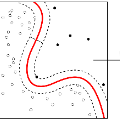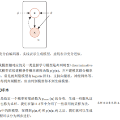Multivariate time series anomaly detection has become an active area of research in recent years, with Deep Learning models outperforming previous approaches on benchmark datasets. Among reconstruction-based models, most previous work has focused on Variational Autoencoders and Generative Adversarial Networks. This work presents DGHL, a new family of generative models for time series anomaly detection, trained by maximizing the observed likelihood by posterior sampling and alternating back-propagation. A top-down Convolution Network maps a novel hierarchical latent space to time series windows, exploiting temporal dynamics to encode information efficiently. Despite relying on posterior sampling, it is computationally more efficient than current approaches, with up to 10x shorter training times than RNN based models. Our method outperformed current state-of-the-art models on four popular benchmark datasets. Finally, DGHL is robust to variable features between entities and accurate even with large proportions of missing values, settings with increasing relevance with the advent of IoT. We demonstrate the superior robustness of DGHL with novel occlusion experiments in this literature. Our code is available at https://github.com/cchallu/dghl.
翻译:近年来,多变时间序列异常现象探测已成为一个积极的研究领域,深学习模型比以前的基准数据集方法表现得更好。在基于重建的模型中,大多数先前的工作都侧重于变化式自动编码器和基因反反转网络。这项工作展示了DGL,这是一个用于时间序列异常现象探测的基因化模型的新组合,通过事后取样和交替反演来最大限度地提高观察到的可能性。一个自上而下的发展网络为时间序列窗口绘制了一个新的等级潜伏空间,利用时间动态来有效地编码信息。尽管它依靠远洋取样,但比目前的方法效率更高,培训时间比以RNNN为基础的模型短10x倍。我们的方法在四个流行的基准数据集上超越了目前最先进的模型。最后,DGHL对各实体之间的可变特征和准确性非常大比例的缺失值(即使与IoT的出现的关系越来越密切)。我们展示了DGHL的超强性强性,并展示了该文献中新的隐含性实验。我们的代码可以在 https://gibth/chal。




